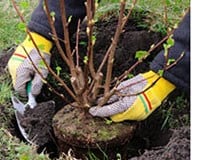Planting a shrub

Shrubs are vital ingredients in a garden. They provide height, structure and year-round interest - as well as creating a backdrop for many of the showier plants. When it comes to planting a shrub, there are a couple of important points to remember. You will need to make sure it is set at the right depth and that the roots are teased out a little from the rootball. It also needs to be firmed in properly. After planting, it will need to be kept well watered for the first year (possibly two) and I would also recommend covering the surface of the soil with a mulch to prevent competition from weeds. This will also help retain moisture around the roots of the plant.
When should I plant?
 Container-grown shrubs can be planted at any time of the year, except when the soil is frozen or waterlogged. Autumn however, is the ideal time for deciduous shrubs because the soil is still warm enough to encourage some root growth before the onset of winter. This helps the shrub establish quickly so that it is more able to withstand any hot, dry spells the following summer. In exposed gardens, or if you are planting evergreens, I would recommend spring planting, which gives the plants a full summer to become established before the onset of their first winter. In these exposed areas, it's also worth putting up a protective barrier of windbreak netting after planting until the plants are established.
Container-grown shrubs can be planted at any time of the year, except when the soil is frozen or waterlogged. Autumn however, is the ideal time for deciduous shrubs because the soil is still warm enough to encourage some root growth before the onset of winter. This helps the shrub establish quickly so that it is more able to withstand any hot, dry spells the following summer. In exposed gardens, or if you are planting evergreens, I would recommend spring planting, which gives the plants a full summer to become established before the onset of their first winter. In these exposed areas, it's also worth putting up a protective barrier of windbreak netting after planting until the plants are established.
Simple steps to success
Before you do anything, make sure the plant is thoroughly watered. You can do this with a hose or watering can, but some people like to let the plant sit in a bucket of water for 20 minutes or so, before taking it out and allowing the excess water to drain away.
Dig a hole at least twice as wide and deep as the shrub's container. Mix the soil you've removed with well-rotted organic matter and leave it to one side. If your soil is heavy clay or chalky, break up the sides and bottom of the hole by gently pricking the smeared surfaces with a fork - this will allow the roots to grow into the surrounding soil.
Gently remove the plant from its pot. The easiest way to get a large plant out of its pot is to gently lay it on its side and, with one hand supporting the shrub, ease the rootball out of its pot.
The shrub needs to be planted at the same depth as it was in the pot, so partially back-fill the hole with some of the soil/compost mix and place the shrub on top. Check that the plant is the right height by laying a bamboo cane or piece of straight timber across the top. Ideally the level around the perimeter of the hole and the top of the rootball should be exactly the same. If the shrub is standing too high or too low, you'll need to either add or remove some of the soil in the bottom of the hole.
Carefully tease out some of the roots that were circling around the bottom or sides of the pot. This will ensure that they grow away from the rootball and into the surrounding soil. Position the shrub in the centre of the hole then stand back to make sure you are getting the best side at the front (this is known as 'facing-up' in the trade). Then, fill in the gaps around the sides of the rootball with soil mixture, firming it down gently in layers as you work your way up to the top.
Once the hole has been filled, gently firm the soil once more - you don't want to squash it in, just get rid of any air pockets and make sure the plant is secure. Water the shrub again using at least one full watering can.
Cover the surface of the soil with a generous layer of mulch, such as chipped bark or composted manure to help prevent weeds and reduce the amount of water loss from the soil.
Retire to a comfortable position and admire your handiwork.





 Container-grown shrubs can be planted at any time of the year, except when the soil is frozen or waterlogged. Autumn however, is the ideal time for deciduous shrubs because the soil is still warm enough to encourage some root growth before the onset of winter. This helps the shrub establish quickly so that it is more able to withstand any hot, dry spells the following summer. In exposed gardens, or if you are planting
Container-grown shrubs can be planted at any time of the year, except when the soil is frozen or waterlogged. Autumn however, is the ideal time for deciduous shrubs because the soil is still warm enough to encourage some root growth before the onset of winter. This helps the shrub establish quickly so that it is more able to withstand any hot, dry spells the following summer. In exposed gardens, or if you are planting 
